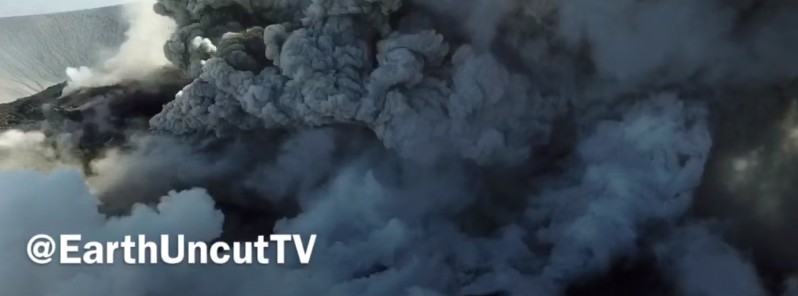Explosive eruptions and ash venting at Shinmoedake (Kirishimayama), Japan

The activity at Shinmoedake volcano in Kyushu, just one of 20 Quaternary volcanoes making Kirishimayama volcano group, is at elevated levels since March 5 with near-continuous ash emissions and ejections of very hot material. At 11:20 UTC today, ash column was rising 3.9 km (13 000 feet) above sea level.
After several months of being quiet, the activity at Kirishimayama's Shinmoedake crater resumed again around 02:00 UTC on March 1, 2018 (11:00 local time).
The Japan Meteorological Agency said Kirishima erupted violently several times today and some lava was rising inside a crater.
Due to the recent activity, officials restricted access to the entire mountain, and the danger zone may be expanded to a 3-km (1.8 miles) radius from the crater.
Today's activity, the strongest since 2011, grounded more than 80 flights at the nearby Kagoshima airport.

Video courtesy Earth Uncut TV
This volcano roared back to life on September 7, 2017 after 6 years of quiescence, coating nearby cities and towns with a thin layer of ash.
#Volcan #Volcano #Kirishima #Shinmoedake Incandescences observées dans le cratère. #Vidéo https://t.co/Jjl8msAkz8
— Shérine (@SherineFrance) March 6, 2018
Today was without doubt the most impressing volcanic “audio” I’ve ever witnessed – at some points the explosions were echoing off surrounding peaks. Take a watch and crank up the volume! #Shinmoedake #volcano #Japan pic.twitter.com/DSU0kQLlpC
— James Reynolds (@EarthUncutTV) March 6, 2018
Damn!! Shinmoedake webcam looks AWESOME, lava filling the crater! #japan #volcano pic.twitter.com/im3WrxwU0L
— James Reynolds (@EarthUncutTV) March 6, 2018
Geological summary
Kirishimayama is a large group of more than 20 Quaternary volcanoes located north of Kagoshima Bay. The late-Pleistocene to Holocene dominantly andesitic group consists of stratovolcanoes, pyroclastic cones, maars, and underlying shield volcanoes located over an area of 20 x 30 km (12.4 – 18.6 miles). The larger stratovolcanoes are scattered throughout the field, with the centrally located, 1700-m-high (5 577 feet) Karakunidake being the highest.
Onamiike and Miike, the two largest maars, are located SW of Karakunidake and at its far eastern end, respectively. Holocene eruptions have been concentrated along an E-W line of vents from Miike to Ohachi, and at Shinmoedake to the NE. Frequent small-to-moderate explosive eruptions have been recorded since the 8th century. (GVP)
Featured image: Aerial footage explosive eruptions and ash venting at Shinmoedake volcano in Japan on March 6, 2018. Image copyright: Earth Uncut TV

Commenting rules and guidelines
We value the thoughts and opinions of our readers and welcome healthy discussions on our website. In order to maintain a respectful and positive community, we ask that all commenters follow these rules.